Reģistrējieties, lai lasītu žurnāla digitālo versiju, kā arī redzētu savu abonēšanas periodu un ērti abonētu Rīgas Laiku tiešsaistē.
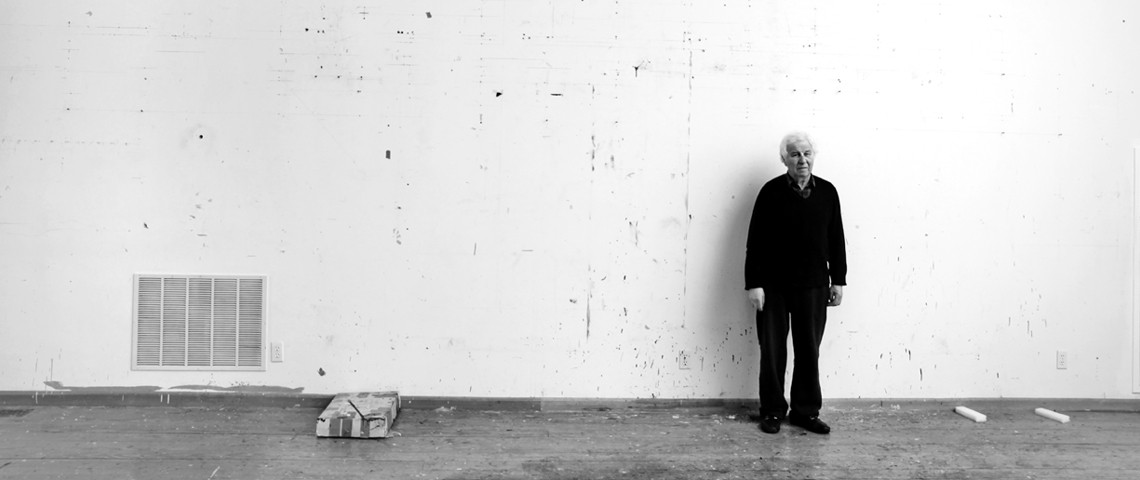
Kabakov is often called the most important Russian artist. This is true and still would be true even putting aside all his awards, decorations and medals, his Venice Biennale ’93 Honorary Diploma and the projects shown there in 2003 and 2007, dozens of solo shows in museums, multimillion dollar auction sales, and his label design for Château Mouton Rothschild. At the turn of the 21st century, Ilya Kabakov was the only artist expressing the Russian sense of form, which is still based on the desire to elevate oneself from the dirt. In our homeland, longing for beauty or dreaming about ideals more often than not results in clumsy and badly made things. Kabakov’s name has become synonymous with an entire layer of material culture that’s gradually disappearing from daily life and moving to museums. When we say, ‘That’s a Kabakov’ about an object or phenomenon there’s no need to explain that we mean a specifically absurd combination of squalor and conundrum.
Kabakov invented the author-personage: he was timid and wily, hiding behind the characters he invented during Soviet times. Later, he didn’t let go of them; Charles Rosenthal went so far as to become his alter ego. Sitting-in-the-Closet Primakov, The Decorator Malygin, Agonizing Surikov, The Man Who Flew Into Space From His Apartment—all these personages could make up the population of a small country. Apart from them, there are rabbits and other characters from children’s books that Kabakov drew for a living. Though the artist isn’t pleased with them, they’ve found their way into many hearts and educated many eyes. And yet Kabakov’s works retain compactness; The Paradise Under the Ceiling installation, with its miniature animals lining up on the cornice along the perimeter of the room, shows how important vertical hierarchy is for the artist.
Standing in front of Kabakov’s picture or inside his installation, you immediately and unwittingly find yourself in a noisy crowd; you may even take part in an exhausting dispute, the subject of which, in its nothingness, could be compared to a fly crawling on a kitchen tablecloth. Just like everyone else in Moscow in the 60s and 70s, Kabakov was familiar with Mikhail Bakhtin’s works. It was Kabakov who created a fresh and vivid image of this dialogism.
At the turn of the millennium, the artist transformed into a new author, Ilya-and-Emilia-Kabakov; since then that’s how all works are signed. They have created incredibly large-scale projects, ‘palaces’, ‘theatres’ and ‘institutes’. Most exist only as models, which proves that Ilya Kabakov’s view of the Russian avant-garde is correct, namely that it’s a project inviting dialogue, in which the artist becomes aware of himself.
At the Skulptur Projekte Münster in 1997, Kabakov showed the installation Look Up and Read the Words, an antenna-like construction with the following text in Russian and German that you could read only if lying under it: ‘My dear! You lie in the grass, looking up / Not a soul around / All you hear is the wind / You look up into the open sky, up into the blue above, where the clouds roll by / It is perhaps the most beautiful thing that you have ever done or seen in your life.’ I suppose, Kabakov was right about that.
Pavel Gerasimenko
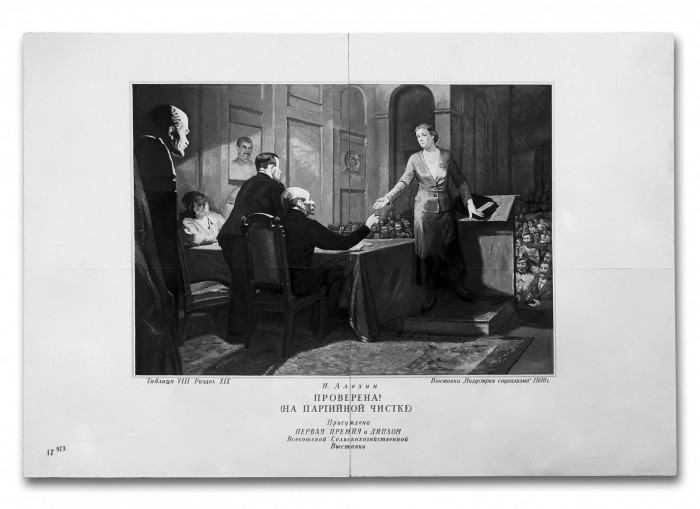
…And of course I have to mention Kostaki1. We would often go to his place, maybe even twice a week, where he would lay the table with food from Beryozka2, play the guitar and be exceptionally nice to us. By ‘us’ I mean the entire unofficial community. He would say plainly to us, ‘Guys, you’ve been overtrumped. You’ve come to the wrong place at the wrong time. The history of art rolls over your heads without touching them.’ He behaved like a prince gathering the gifted around him, so to speak.
People pretend they know exactly what Moscow Conceptualism was. But when I—someone who has no direct connection with art—read about, looked at or tried to understand or find out something about it, there was still no…clarity. Everyone knows each other, writes about each other, and understands everything. Have you ever faced the necessity of answering the question: What does it mean to be a Conceptualist?
There are two sides to this question. One side is that you can actually touch this whole conceptual circle. There were artists, pictures, objects, texts. A lot was said, a lot was written, a lot was drawn—and all of that is preserved. It’s not a sunken ship, the giant one, I forget her name…the Titanic.
Yeah, the Titanic. This is still a floating mass. Besides, all these people are well-known, most of them are still alive. These are real people and a real environment, social situation, in which it was happening. Those rooms, studios, flats still exist, as do the material signs and documents. However, they aren’t enough to understand what it was all about. It’s like a game when you can touch, but not catch. You can touch, but you can’t understand.
Emilia Kabakova: May I also ask a question? Do you understand what Western Conceptualism is?
Without trying to define it, I seem to understand. But if you want me to give a definition, I’d say, this is art closely connected with some hidden idea.
Emilia Kabakova: I think it can be defined very easily: it’s an art that constantly reflects on everything. What is conceptualism? It’s reflection. The subjects of this reflection may be life, art, the opinions of others, the works of others, texts. Western Conceptualism was started by a small group of people, so these subjects are connected like chain links. Remember Kosuth’s ‘Chair is a chair is a chair is a chair’? He didn’t invent that, did he? Yet Western Conceptualists produced many objects, performed a lot, and so it became more clear and acceptable for society. We know who they were. Even if I haven’t read his works, when I see Kosuth’s objects, I understand that they are a reflection of something different. It is something he says about an object or subject or event or phrase. The principle is that he uses someone else’s phrases. Russian Conceptualism started with conversations and, unfortunately, ended mostly in conversations. It was a reflection, but it was done by a very narrow circle.
Are you talking about Russian Conceptualists?
Emilia Kabakova: Yes. It is a very closed community, so when you hear about conceptualists you ask, ‘What’s happening in that conceptual circle?’ Well, they talk. But you don’t understand about what.
It’s those talks I wanted to ask about. Why has talk become an essential part of art?
The Conceptualist circle emerged in the late 60s and early 70s for a number of reasons. First, because life was unbelievably artificial and idiotic in the Soviet Union. I’m talking about an impossibly didactic ideology that tried to raise an ideal, noble, honest, straightforward person. Let’s call it an ideological blanket that covered the entire country. This blanket concealed the most horrible things going on underneath: the endlessly evil, dreary, sombre, filthy, desperate life of people who had nothing to do with this propaganda and educational system. We lived inside an artistic installation, so to speak, that had no regard for people. There are texts and films about some abstract creature, but the real creature was a frightened flock that could do nothing under that terrible blanket of surveillance. The fear and horror of this grey creature that populated the entire territory of the Soviet Union can be compared with the tortures in prison camps that don’t amount to killings. Basically, it’s a prison camp with all the pertinent circumstances except for ongoing executions. A Soviet person lives in constant panic, he feels a hysterical fear and expects someone to come and do something to him. This dismal standard of life goes on and on. You have to come to work, even if there’s nothing to do. In fact, it isn’t a job, but rather an obligation to be present at your work place. It is an incredible life without people and virtually without a country. As Mandelstam put it, ‘We exist without sensing our country beneath us…’ I’d say, our generation sensed not just the country’s absence, but the absence of the subject of life itself. It’s like there were no people in this world. There was nothing but a lump of fraud, dissimulation, fear, and this incredible pretending that we were Soviet people.
Still, there was a trick in Soviet life: though the blanket covered everything very evenly, the axe that chopped it—or the hammer that smashed it, I don’t know—would sometimes skip a beat. A peculiarity of Soviet life is that the hammer, even if it hit and smashed right in front of you, might still miss you if you managed to find some spot in the corner. It would be smashing all around you, but you’d be intact. It didn’t aim precisely.
In the 70s?
Yes, the 70s. Before that, each and every one was under very precise fire. Entire classes were obliterated, everyone on the list. We didn’t witness that bloodshed, but we saw the 60s and 70s when the axe no longer worked indiscriminately. We could gather. We could talk. On our time, free from work, so to speak. People gathered in the kitchens.
The Soviet power made a few mistakes. The biggest one was education. I wonder if Stalin had some complex about gymnasiums and Western style education or… Soviet school was modelled after the German gymnasium; it wasn’t an original system. There was a unique propaganda system, but the education system followed the principle ‘Soviet man is the last stage in the development of mankind’. Soviet man stands at the climax of mankind and inherits its best achievements.
So, an absolute mind has realized itself in the Soviet man?
Of course. The road from Leonardo da Vinci to the Soviet man was a straight one: Leonardo da Vinci, Michelangelo, Rubens, I don’t know, Repin—they were all caryatids supporting the advent of the Soviet man. This ideology was palpable in art education. Our art history curriculum—and I finished both art school and the Surikov Academy—included ancient art (brilliantly taught by Chegodayev), Russian art dating all the way back to icons (read by Tretyakov), and Western art (naturally, up to Barbizon). All later art was forbidden. Still, the Barbizon artists were brilliant, and the great Alpatov read to us the entire history of Western art—from Greece to Barbizon.
It was due to this concept of the Soviet man, heir to the best, that the Pushkin Museum and Tretyakov Gallery were preserved, as well the Bolshoi Theatre and libraries—of course, all of them are the classic type. Thanks to Gorky, the World Literature series was published so we could read classic English, Italian, French books and so on. What did this lead to? It led to an interesting paradox: while people in the USSR lived the life of cattle, of some degenerate Mowglis—half-beasts, half-men—in the realm of education this cattle seemed to realize that a history of mankind existed. It’s the story of a Mowgli who used to dance with apes and Bagheera in the trees, but then descended and discovered some stone sculptures, ruins, a town. He walks through this town, touches the sculptures, and starts to recall in his canine, beastly head that he was once a man. Touching the ruins was the moment we recalled that we looked like men.

Let’s get back to the Conceptualist circle. The Conceptualist circle is… Well, they aren’t exactly successors to the European intellectual Enlightenment and art history, which gave birth to the Russian intelligentsia. The French and German Enlightenment tradition blended with Radishchev, Chaadayev, and Herzen, and led to the formation of the great intelligentsia; they were like a class. But we didn’t belong to the intelligentsia. Our parents were nice, decent people who had clean professions. I am not going to analyse Lev’s3 biography in this regard.
Whose biography?
Lev’s. For example, my parents didn’t belong to the intelligentsia in any way. I am a pure Soviet Mowgli, and there is no way to understand what triggered my recollections. Recollections of what? Recollections of culture. The Conceptualist circle was obsessed with universal knowledge. By the way, that was also the basic principle of the Enlightenment as taught in German gymnasiums. A normal person should know everything. This omniscience was inherent in the Soviet education system: we knew chemistry at a university level; we knew geography. We studied Madagascar though we knew we would never go there; we would never even go to France. Yet we knew a lot about France. I mean these schools tried to teach universal thinking. But it was cultivated in small circles within a classroom. Generally, a classroom was full of thugs. Mine was no exception. They were sadists who beat up their classmates, particularly those wearing glasses.
Did you face antisemitism in school?
Of course, there was horrible antisemitism. It didn’t affect me directly though because I had a Russian last name and not a typical Jewish face. Students were bullied all the time. The teachers couldn’t teach us properly because there was always a beastly atmosphere in the classroom: we laughed at the teachers and pulled pranks on them. But even in that atmosphere, some Mowglis would gather in little groups because they wanted to study. Our mysterious self-learning process continued throughout school and even university. Our group consisted of four or five friends; each had his own specialisation and was responsible for a particular cultural sector. One explained music to us: he lectured about Schoenberg, played records for us at his house. Another friend taught literature. We read forbidden poets of the Silver age. Their works existed only in manuscripts—Akhmatova, Mandelstam, Tsvetayeva, etc. The third would take us to the theatre, relate its history, and even manage to find tickets. It was a real self-education based on our initiative. No one knew about it because we gathered after school. It was a mysterious process, a process of recalling culture at a molecular level that developed intuitively in groups of pupils and youths. We were the illiterates longing for literacy, but not the official kind.
Are you talking about the 50s?
Yes. Our circle emerged through shared interest in culture, not art.
Are you referring to the Conceptualist circle?
Yes. We found each other in Moscow by recognising the signs of hunger for culture that everyone already had in himself. We met because each of us was seeking the same thing and understood the utmost importance of cultural skills. It was a phenomenal cultural explosion, and each of us is still a part of it.
And where does the talk come from?
It was because we discussed any subject from a general cultural perspective. That was the talk. If you read a text by Pepperstein and his Inspection Medical Hermeneutics group you’ll see that it’s nothing but a talk about various meanings and associations within a cultural field where a phenomenon is inspected. That level of activated reflection is unique in any sphere. That’s why any opinion given by a critic today seems too narrow, too professionally constrained. I’ve never seen the same range of reflection as we had in the Conceptualist circle.
What were talks in that circle about?
It could be any subject. If they came to my studio, we might start off by looking at a picture.
Your picture?
Yes, my picture. We would immediately go down various corridors of reflection about it. The more diverse and deep the connections involved, the more interesting it was. Saying it’s merely good, bad, beautiful, or ugly is a monkey level of reflection.
That’s why works created in the Conceptualist circle are different, they’re multifaceted. They don’t follow a certain direction; they are simultaneously pro, con, askew, inside, sideways. We were enthusiastic about not being Soviet people. We called ourselves a geography club with its headquarters in London. This is an allusion to Livingstone’s expedition into the depths of Africa where he studied savages. Livingstone admits he would have learnt next to nothing had it not been for those traitors, or rather witnesses, who came at night to tell him about tribal life. When they encamped by a settlement, at night some defector would come and tell him things. We thought of ourselves as Livingstones living on the Soviet animal farm. We were no strangers to that world; we were the cattle—but the cattle that can observe the barnyard in general. It is an ambiguous position and a very interesting one.
And yet this self-definition of the Conceptualist circle was a response not just to the Soviet environment, but to other circles of unofficial art as well.
Of course, we discussed everything. There was only one forbidden subject: daily routine. No one cared which wives others were living with, how much a sausage cost, who found a job.
But at the time you didn’t say something like ‘Let’s go to our Conceptualist circle’? Right? You’d say, ‘Let’s meet at Kabakov’s…’
Right, we weren’t bombastic or pompous and didn’t pretend to be members of some order. There was a friendly atmosphere. We kept it that way. However, there were some artificial hierarchies. Someone held a military post. There was a lot of mockery going on, but I repeat—the cementing power was a belief in the value of cultural analysis.
Can I say that the term Conceptualist circle was coined by others and not you? That it was an outsider’s definition?
Yes, I think it was. Although everyone thought he was doing something conceptual. And conception was quite a formal idea—that everything is governed by a project. That in life, there’s nothing more valuable than a project. (Laughs.) That this world is also someone’s project. It hasn’t emerged by itself; it’s someone’s project. So I always knew that my works were a project. Lots of projects.
Anything could become the project’s contents?
There was only one condition: the project should be incredibly broad. It has to be deep, dramatic, global. It should involve everything. In principle, your work of art should involve everything.
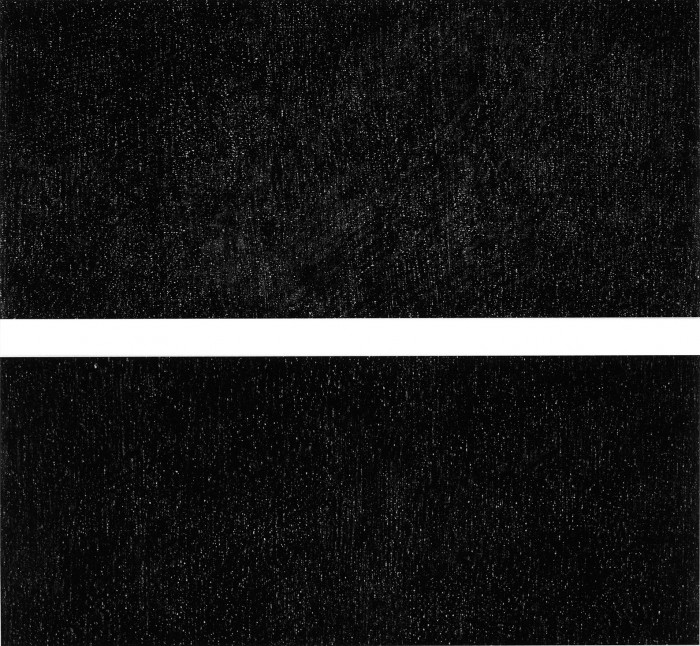
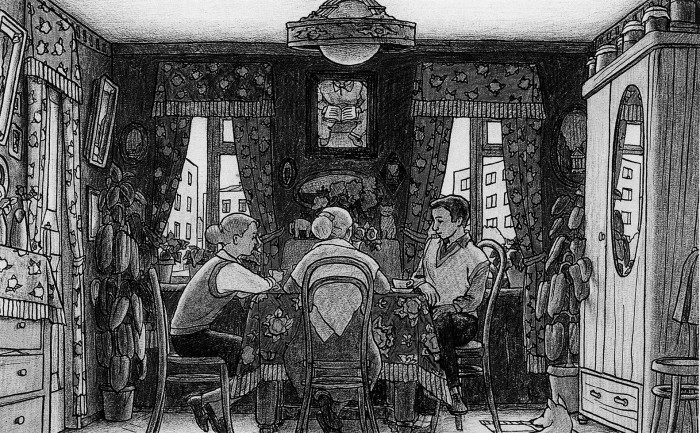
Ilya, you keep mentioning culture, which I somehow find annoying. It reminds me of talks about the ministry of culture or that people should be culturally developed. It makes it seem like culture is something already made, and in that mode is not just a contributing force, but also…
A suppressing and inhibitory one.
It suppresses and inhibits an artist or any person who thinks.
As I said, I belong roughly to the third generation after the Soviet revolution, and we are nothing but half-beasts gone wild. However, we still hear weak voices in our head—that’s culture. Therefore, this conflict between the wild creature I am and the sounds of culture is my primary subject. My question is how to turn from beast back into man.
Yes.
This is an attempt to recollect because simply going back is impossible. Genetically, we are cut off. But getting back, looking back at the world of—naturally—Western culture was the key subject of my life. So it isn’t surprising that I idealize culture as a gigantic reservoir of values that I as a beast have lost.
When I came to the West I saw that culture could be everywhere, not only in the subjects that represent it. For example, Beuys acts like a shaman and a beast gone wild, but he’s a beast within culture. He’s a wild and naughty child who doesn’t want to eat off a plate. He wants to slurp from a bowl on the floor and bark. Why? Because he’s fed up with culture. On the other hand, I am a bastard. Beuys is happy to go wild. I am wild in the first place and I’m happy to sit by a nice plate.
When you talk about your life, in particular, life at the boarding school, you often use biological metaphors. You’ve also compared that life to life in a prison camp. Some educated people survived in the camps because they were reciting poems and novels to their fellow-prisoners. Isn’t your interest in culture and those kinds of talks merely a survival strategy?
That’s brilliant, just brilliant. I think you’ve made a very important point. I would have perished if I hadn’t breathed that air in through a straw. That’s for sure. And later, when I met other people with breathing straws on the surface, we sighed with relief. Sorokin employed a similar metaphor: we live under a cone full of water; there are bubbles of oxygen inside, so everyone has to stick to them to breathe.
When you say these rather noble things about your circle’s shared interest in culture, I think to myself: How do you feel about those artists who never fed on such cultural subjects and yet somehow received them, as if from air? There’s a cultural barrier between yourself and, let’s say, Being. In order to get to it, you have to force your way through a very thick layer.
When I relate these things, I’m referring to a life principle, an ideal principle. It’s no coincidence that over those 30 years the Soviet murderers didn’t break in, tear everything to pieces and throw it away. Not just our surviving in Soviet society over the course of 30 years, but our living the way we wanted to is utterly remarkable. This is why I’m panegyrizing culture, the sublime circle of my friends and so on. Of course, the very same phenomena may have a negative impact: culture may cover you like a blanket and stifle you. But, some favourable conditions nurtured optimism, and that’s what happened in the Conceptualist circle. First of all, we lacked any interest in life whatsoever. You might say that none of us lived. I was a little child when I realized that living in this world is impossible and that one should escape to a different world. The Soviet regime was helpful in that regard: we didn’t have clothes, food, places to live, or freedom of movement. So it was easy not to live in that country and to move on to permanent and, let’s say, artistic, fantasizing. Besides, you weren’t alone: there were similar fanciers nearby, with their abstract ‘White Nights’-style4 dreams. This might call for a mundane question: How did you fuckers manage to make a living if you did nothing but dream, paint, continuously visit each other and talk? There’s an underlying question there: How can an artist survive nowadays? Can he give up on everything and resign to fantasizing, painting and talking with friends? But Soviet life powerfully induced double consciousness, twofold thinking, which we don’t see today. Soviet life was a pretence, a fraud, a deceit: if you fulfilled your duties and met the current requirement, Soviet power didn’t care about the rest of your life. For example, people would come to the factory and do nothing but steal within the scope of what was considered permissible. If you worked at a power plant, you could steal wires. My nephew worked at the dairy factory, and his status there allowed him to steal a pot of butter. This fictitious, fake Soviet existence gave you an opportunity to work and receive a squalid salary without investing your human substance into any of it. So, every one of us had an official job, which provided us with a living wage.
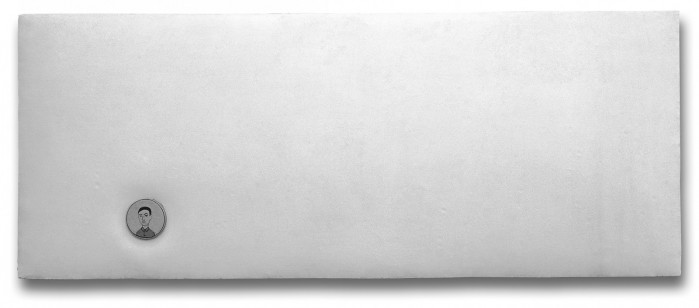
That’s what I wanted to ask: Everyone went to work, but this work was nominal rather than real?
Absolutely.
And everyone had collected works of Dostoyevsky at home, which was also nominal in a way.
That’s right, children’s books.
You’ve said that when you were drawing rabbits, you weren’t really drawing rabbits.
Of course. I was drawing something that others perceived as rabbits.
But then you could say that Conceptualists weren’t drawing rabbits, but the ideas or signs of rabbits—just like the money and ration cards everyone in Soviet society was receiving.
In a way you’re right. It was pseudo-art. We didn’t recognize it as grand art or serious art. It was ‘so-called art’. And yet paradoxically, there is nothing that won’t eventually receive the status of art. The pseudo-paintings I was making (knowing they were not real paintings) have now gained the status of paintings. In art history, before you know it the pseudo intermix with the nominal. People who buy paintings don’t care about the reason they were made. You can say a hundred times that those are ‘pseudo-paintings’. If it’s a board smeared with paint, it may become a painting one day.
Did that double life of yours continue when you moved to the West? You wrote that you were playing a role, ‘If you want me to be a Russian genius, you can have it.’ Right? And you also played a role in the boarding school, the role of a good, cheerful boy. And so on. So you’ve always played roles that you were allowed to play. It seems that you’ve positioned yourself as an observer since you were a little boy. Here you’re a husband, there you’re a Conceptualist artist, there you’re a successful Russian artist living in the West, but none of it has anything to do with you personally?
No. When your life is just starting out—particularly in such a harsh society as the Soviet one—you don’t have a chance to be yourself unless you’re protected by your parents. Unlike being raised in a normal family, you aren’t cultivated to be yourself. You’re pushed into a circus where you can choose between being a rooster, a horse, a lion and so on. You become an actor wearing a mask before you have a chance to define yourself. In Soviet society, that happened very early—in the children’s communities. You didn’t have a rear. Having a rear means that even if you’re called crazy and degenerate at school, you come back home where your dad says you’re a serious mathematician and your mum says you’re gifted. So there’s a place you can retreat to. You come out to the front at school, and then back to the rear where you feel comfortable. You can say, ‘I won’t go to school; they think I’m stupid’ and so on. But when you only live among other children, you don’t have that rear. You have to act day and night. Besides, wearing a mask, being someone else, is easier than trying to find yourself even for your own sake. You’re like pulp. I’d say you can’t become yourself when you’re very young.
Classic autobiographies also show that ‘being yourself’ is something you achieve at a mature age. Of course, in the 19th century people generally came of age earlier than in our days. I for one felt like an absolute child when I was 26; I was fluid and shapeless inside. But when you read Tolstoy’s biography, you see he started formulating his original concepts at the age of 12. Initiation plays a very important role. Someone outside your family has to say, ‘You are an artist, you are smart, you are gifted.’ Someone from the outer world must cover you and touch your shoulder. In Soviet society this kind of initiation didn’t exist in either the art world or normal life. It did exist in the theatre and music worlds; the structure of initiation survived there, Heinrich Neuhaus initiated Sviatoslav Richter and so on. But in my environment—let’s call it a generic Soviet environment—initiation couldn’t have happened. Ours was a standard Soviet environment, an abhorrent dirty mess, nothing like the world of ballet, theatre or music. Our teachers slept on chairs and had no interest in their students’ lives. So, articulating yourself was a long process, foggy and gradual, while picking a role under external pressure was instantaneous. So when I started drawing, I had no difficulty drawing on behalf of whomever. On behalf of a mediocre artist, a municipal housing clerk, a Soviet artist and so forth. But what I myself wanted to draw I didn’t know.
Do you know now?
Yes, now I know. Since 2000 or maybe even earlier, since I started making installations, I’ve been working on my own behalf.
So you became yourself at the age of 65?
Yes, around 65, you’re right. Before that I played various roles, a describer of Soviet life, for example. I felt like Sinbad the Sailor telling stories about this cursed country: ‘Just look at what I’ve brought from that land!’ There were lots of roles, and all of them looked historically authentic. That’s what’s most interesting. A traitor talking about life in his horrible country is a widely known role. There’s a vast literary tradition of defectors’ stories. Kurbsky, for example, who fled from Ivan the Terrible. Herzen, Radishchev, Chaadayev, and I’m not even mentioning contemporary escapees. Telling stories about your cursed land is a huge tradition.
You said that early works were a conversation starter.
Yes.
Would you say the same about your latest works?
No, they’ve changed, they’re different. I’d like to finish the first act about self-identification. You begin to identify yourself with the fictitious production of some boards, pictures, drawings, projects. As you live, you keep producing. And through this you become yourself. You become not a person, not a someone, but a something that lives by it. There’s a certain danger here because you can be a mere craftsman, a professional, an effective self-promoter, or you can go crazy and say, ‘I’m a talented genius!’ It’s tempting to account for this continuous production by referring to some special qualities of yours. I also reflect about the sense of continuous production. It goes like this: I studied in art school, so I can imitate any style; I learned how to be a Soviet painter; I learned how to be a second-rate book illustrator; I learned how to make a pseudo-15th century picture, a pseudo-Repin and so on. I studied it in every detail and can make reproductions. But after I finished art school I didn’t know what I myself wanted to draw. Do you know that famous joke about Laurence Olivier? A rich woman invites him to her house and asks, ‘Can you spend a night with me as Napoleon?’ So he does. Then she asks, ‘Can you spend a night with me as Nero?’ He does that, too. Long story short, he spends nights with her as many famous persons. Finally, she asks, ‘Can you spend a night with me as Laurence Olivier?’ and he replies, ‘Madam, it is impossible because I’m impotent.’
Something like that happened to me after I finished art school. I could draw a picture or an illustration like a Soviet artist, but I didn’t know what I could draw when I was all by myself and free. I started doing some crude abstracts, but then I found out someone had already made something like that. I was at a dead end. And then fate—as I call it—condescended to give me a gift. It was a principle, or rather an observation. I started drawing anything that came into my mind. Not something I invented, but what emerged by itself, so to speak. They were like visions. I could see all the details, the texture, the hues. So the pictures emerged from my…well, I don’t know…the sphere of gift. I started drawing what emerged in me without my interference. From that moment on, I felt comfortable. Something emerges in me, but I don’t invent anything. This principle still stands. All my pictures and installations emerge after I’m done with the previous ones. It’s almost physiological, like a bowel movement. Once you’ve finished something, the next thing
appears.
There’s still one thing I don’t understand. Previously, your works were conversation starters. What are they now?
They originate from me. What does this ‘from me’ mean? I think we live through different ages, and each age is a separate personality. One personality gives birth to another, which hatches from the previous one. There are lots of ages like that, but I think that I’ve lived through three. First is the age when, speaking in railway terms, you come out on the platform and see a train. You have to get on, but it’s very hard. You’re hanging about with other people on the platform and see that you need a ticket, which you, of course, do not have. How do you get inside the carriage? There’s that mean conductor and so on. And then there are the lucky ones who have the ticket. Long story short, this is childhood. It’s an age when you come out on the platform; you have to get on the train, but you don’t know what to do.
It reminds me of your work: a boy who can’t get out of the toilet.
Yes, if you will. You could say so. The second age is when you mysteriously… There’s something they call ‘empty action’ in China. There’s a famous illustrated Chinese story: a bull is gone, and a boy goes out to find it. He looks for it under the mountain, in the forest, at the neighbours’, in the grove, but the bull is nowhere to be found. It’s gone. Then there’s a picture of absolute nothing. It’s where the boy finds the bull and then takes it home. So he found the bull in the sphere of the unknown. There can be many hypotheses as to how you managed to get inside the carriage. We can even know it formally. You could meet a good person or a teacher. But psychologically we know that all those circumstances are nothing compared with that strange emptiness, a gap that carried you over to a different age. This second age is adulthood. You’re sitting in a carriage among…what do you call them? Drinking partners? No, fellow travellers.
They could still be drinking partners.
They could, that’s for sure. They’re your co-travellers, and that’s your carriage. You and your contemporaries, drinking partners, occupy the entire carriage. Those on the platform are left behind, and you’re going in your time and in your carriage. Those are happy days; you got lucky. Someone is applauding you somewhere on the side. No one is trying to rip your head off or kick you. We’re going along in our carriages, and this is our time. If you’re lucky, if circumstances work out, living in your carriage with contemporaries is your middle age. If you lived it properly, you may count yourself lucky.
And then, after the same transition through the darkness, you reach the third age, which is the final part of life. My transition happened when I was 67 or 68. It was around the year 2000. You feel that the carriage, inside which you choo-chooed so nicely (with a full set of drinking partners: artists, critics, museum workers, curators), has shunted to a side track. It’s going slower; other carriages are passing by—they’re just like yours. They’re going somewhere at a decent speed. You hang out the window and yell, ‘I’m here! I am an artist!’ But no one pays attention, they’re passing by while your carriage with your nice drinking partners (some of whom stepped off for some reason; others got lost on the way) is going in the wrong direction. You’re sitting inside that carriage, and you look unhappy. Of course, you’re cursing silently—it was such good company. A normal person understands: your time is over; you’ve reached your Petushki5. Now it’s time for those who have just come in from the platform to go further; it’s their turn. Now it’s them going in their carriages. They don’t know that they’re heading towards a dead end, but they’re on their way, paying no attention to you.
This is especially disgraceful because you think you’ve accumulated this vast experience and you have something to say. You open your mouth to say, ‘Aaah!’ but they won’t listen. What should you do in such a situation? You used to live at full speed; everything was fine for you, everyone was after you, right? Ballerinas sent you invitations, musicians called you—and now no one calls you.
Everyone who’s overstayed in the carriage has a choice. Some will give up on everything and start breeding horses on a farm; others go for walks or sightseeing. What happened to me is this: instead of feeling forlorn and forgotten among younger fellows on the next track, I suddenly lost interest in today’s carriages and headed in the opposite direction in my own carriage. Now everyone I didn’t notice before has become my friend. I stand in front of a Titian in a museum hall and understand him as if he’s standing right in front of me, like I’m sitting in front of you now, I hear him; I understand why he painted this picture and so on. So the entire world of the past, its history, has become contemporary to me. I’ve become a participant in the past. Now my values are the values of those people. I have realized it’s who I am. The person talking to these people is me. They are interested in hearing what came into my mind, and I am interested in knowing what they think, and we think alike. So, the history of art has become… Well, it has always been important because it’s the realm of immortality, but the most important thing is that the history of art is full of living creatures.
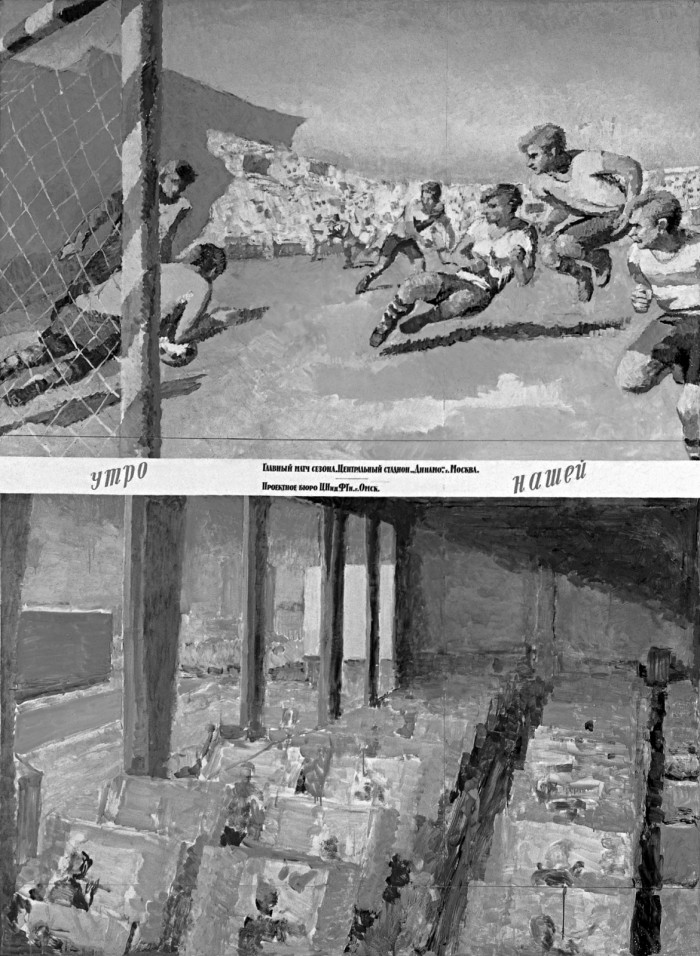
You just mentioned the realm of the unknown. Did anything change in it after you entered the third period of life? Has anything shifted?
It has: more and more you feel like a medium. You constantly become some sort of a tube, a lens, through which the unknown comes to this world and to the future.
So you are a tube?
Yes. I think man as such is a tube, and an artist, in particular, is a very responsible tube. Every man is a tube. Every man is a bridge with a parcel from the past going across it. You know, when they load luggage onto the plane, they use a conveyor belt that goes up inside the plane’s belly. You throw a case on the conveyor, and it goes chug-chug, disappearing into the obscurity of the plane’s belly. So every man is this…
Suitcase?
No, not a suitcase. A suitcase is something that doesn’t know what is carrying it. A man is a conveyor. Or rather…
A converter?
A converter. Something is streaming through him from the past into the future. A man does not live in the today. Not only does a man not live in this world, he doesn’t even live today.
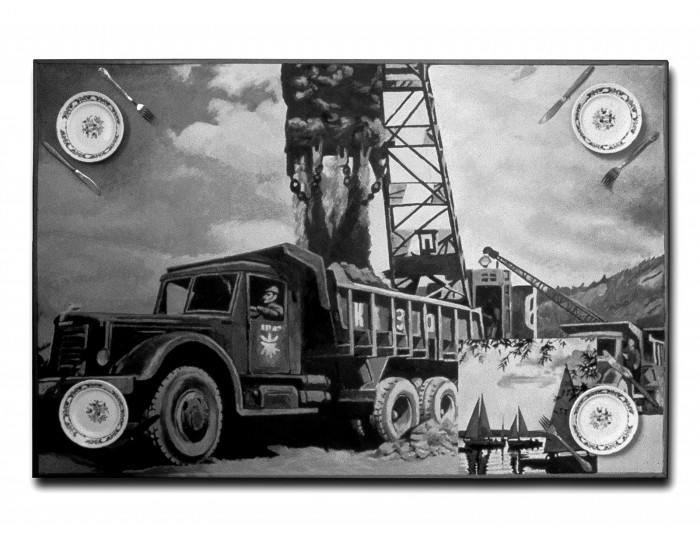
Ilya, on the one hand, you say life is shit; on the other, that your works come to you from somewhere and you don’t invent them. So where do they come from?
The emergence of all pictures and all drawings is absolutely automatic, unconscious. They come in ready and can only be reproduced. It feels like I switch off my consciousness, and my head is hit by something in the form of images. The same technique applies to installations. They also emerge instantaneously at the spot circumstances offer; for example, in a museum lending its space or a public space where something is to be done. Installations are defined by what the Germans call der Geist des Platzes, the spirit of the place. It’s as if you harken to the inside of the place, and it reveals and prompts something in your imagination. As for the pictures, there are three ways to make them (I’ve written an article about it). The first method—let’s call it graphic pictures—is this: they emerge by transferring a drawing to a canvas or a board. Of course, they change in the process as the picture has its own autonomous laws; the drawing acts differently on paper. Viewers usually don’t see the paper behind the drawing; they only pay attention to the lines, to something drawn on white paper, while in the picture, the white is part of the space, which makes it deep. According to tradition, a picture requires the presence of foreground, middle ground, background and other deeper grounds; these belong to the gene memory, as it were, of pictorial production. One can certainly say that avant-garde nullified depth. However, the origin of my pictures has nothing to do with avant-garde. As I said before, we have a terrible, awful gap in our education because it ignored all the great achievements of avant-garde. Our disinterested and slow professors taught us to take over the art of the 19th century. So, transferring drawings had nothing to do with avant-garde; it was based on certain fantasies that emerged automatically and that usually had banal and sometimes ironical meaning. On the one hand, they were based on childhood associations, children’s books. This is impossible to deny. On the other hand were associations with the incredibly bureaucratic, nauseating and mediocre anonymous pictorial style of Soviet everyday life. This accounts for the banal mixing of Russian signs, blueprints, receipts, and other trifles with the idea that they can be interpreted in a sublime, metaphysical sense. I repeat: there, white plays the role of a neutral background. And in the pictures…
Sorry, you said neutral?
Neutral, anonymous background of the picture. On the one hand, it’s a sort of platitude, stupidity, primitiveness; but on the other, it’s a claim to something sublime, metaphysical and irrational.
Let me interrupt you for a moment. Isn’t platitude a quality of any society, not just the Soviet reality?
Of course. Platitude is universal. Banality, platitude, mediocrity. At the same time, platitude is very important because it’s a synonym of clarity. Platitude is always easy to understand. And I believe that fine art should be clear. It has to show.
But that would be boring.
So I repeat: if you manage to mix platitudinous material with the irrational and sublime then you have an ambiguity, which I find very important. It can be read as trite, stupid, and boring, but at another level, it has many meanings, it combines distant things. What is art if not bringing together distant things? It’s a package combining something incredibly base and obvious with something distant and ambivalent. If you manage to grasp this composition, it starts to exist. That’s how a good drawing is born.
Didn’t you say that the white is a sign of depth and this depth often transforms into void?
Of course.
I wanted to ask what the relation between void and nothingness is, in your opinion.
I see void as very potent. It is not nothing, it is something. It is a thing. A thing we don’t see. We can’t see it with our eyes, but we can easily see it with the back of the head, as it were. It’s a potential hidden from direct observation but open to an inner eye. Besides, as I said, void has a great illuminating potential. The white can be understood as a screen that reflects a very powerful and energetic light, a dazzling white light coming from the utmost depths. We don’t know the source of this light, but it is positive, virtuous, and so on.
You’d rather not use the term God in this case?
Sometimes, as they say, keeping mum is the right choice. This is a mysterious issue. If the light comes from unequalled depths and possesses incredible energy, what can we say about it? We can call it anything we want, but it’s something distant and sublime. The white is the light.
I find it strange that you say you mix the banal with the sublime, but at the same time, your works turn everything into dust.
Yes, into dust.
So I was talking about transferring drawing to canvas. If I feel that a drawing has great potential then I can transfer it to canvas. The white plays the key role in this process, whereas in the drawing, the white is just background.
My second type of picture is the one that emphasizes reality. I’m very sensitive and though I hate all this reality, I’m besieged by it. I don’t know what reality is, or rather don’t want to know, but it’s always there. It’s like an intrusive neighbour that you just can’t get rid of. So the second group of pictures was made with reality taken into account, as it were.
What reality are you talking about?
The one stuck in the corneas of your eyes.
So it’s something present as conditio sine qua non?
A mandatory presence. It’s a presence.
Starting from material presence and ending with…
Yes. Cultural presence, non-cultural presence, physiological presence. It pesters, it hurts your eyes; you can’t escape it, it’s always around. So I’d call the second group of paintings a response to reality. These show how I hate depicting reality. I’ve never loved or been good at drawing from nature. I don’t understand reality, I don’t believe in it. I lack that Dutch attitude to it.
As far as I understand, in your illustrations you drew depicted rabbits, not natural ones.
That’s right. But when I moved on to depicting reality, I chose the most dead method—the camera. Even the camera wasn’t enough; I had to double its deathly character. It was easy to do; I started using photos published in Soviet magazines. They’re very low-quality photos: misalignment, lousy colours, especially in the 50s. You can hardly tell they’re photos: they’re so cleaned out, censored, and retouched for magazine use. Just imagine how nasty they are. However, that nastiness perfectly reflects my attitude to reality. This photographic nastiness perfectly reflects my feeling that it isn’t reality, but rather a phony reality. Yet everything’s there—sky, trees, smiling faces, and I used all of them in my pictures. I don’t know who’s depicted there, who these people are. These pictures are initially anonymous because when you depict reality you can’t help distinguishing the significant from the insignificant. It’s a tradition in photography generally, and it’s rooted in the pictorial tradition. I depict the protagonist in the foreground and the rest in the background. Or I depict a horse in the foreground and non-horses in the background. What I like in the depiction of reality in a Soviet magazine is that I repeat it when I make it. By transferring it to canvas, I draw it for the third time. I absolutely don’t care what’s shown there. I don’t know the people I’m drawing. For me, they’re just stains. Not the Cézanne stains. These are the real ugly faces I see in real life, the same trees and same fences. And I like it that I don’t want to know. That’s how I get that so-called cling film of reality. It’s a two-dimensional tightly stretched film, which is what had to be proven. This film envelops my eyes and my psyche. There is nothing beyond it. There is no Ivan Vasilyevich, no horses. There is no one. It is just some stretched fabric—just like Nabokov’s fabric that tore, do you remember? In the Invitation to a Beheading. So when I manage to…not manage, but just use this dirty film, I’m very satisfied, and I use it in all my pictures, this stretched film of ‘reality’. But I never depict it in full. There is no reality.
At the same time, I don’t know how to get rid of this fabric. This is the second technique. When I depicted that fabric of reality I inserted two elements: the white and then, in the last stage of life, the dark. I suddenly realized that the white was an insertion of reality. Then almost half of this reality, a large plane of this reality, became obscured by some darkness. I made large black pictures. They were huge and very dark. And that’s how this incredible arc appeared—I’d already made such pictures. First there’s the white, then reality comes in, then there’s half-dark, and finally the arc ends with dark fragments of this reality.
Do you attribute the white and the black to reality?
No. I know for sure that life is enveloped by two worlds. The white is much larger than reality, and the dark is much larger than reality too. So reality hangs loose like a piece of cloth somewhere in between but doesn’t obscure anything. I mean, for a regular person, it obscures the white and the dark but not for me. Even when reality is stretched you still see the white and the dark showing on the sides. It’s white at the beginning of life and dark at the end. So much for my realism paintings.
Then there’s the last group of my paintings. Let’s call it artistic daubing. That kind of media doesn’t require the use of photos, or rather prints; it employs imagination. It’s a real autodidactic technique. It’s like when a person knows how to draw a horse, but it has nothing to do with any particular horse. These pictures show an impressionistic image of something the artist chooses. He’s like an uneducated amateur who wants to look like he makes real pictures. Do you understand? Let’s say there are primitive, naïve artists, and they produce high and acknowledged art. But the amateur art isn’t acknowledged yet, even though it’s as great as the naïve art. It isn’t adopted by the history of art or by high art. But I think it’s a good technique. It’s impressionistic, it seems like some kind of daubing; usually it’s landscapes.
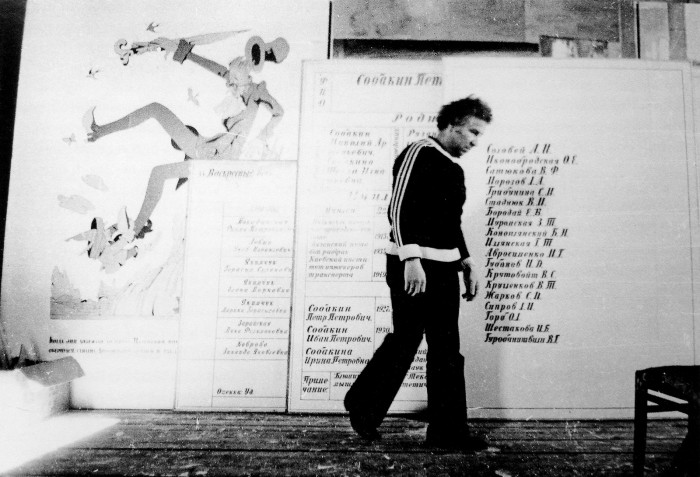
No matter what art you’re doing, it bears an imprint of your personality.
There’s nothing you can do about it. There are two kinds of self in art. The first is an active and persistent urge to show yourself in your works.
Are you talking about yourself?
No, I’m the opposite kind. I’m inclined to not show myself. I don’t know who I am and don’t want to know. I’ve never felt the urge for that famous identity, which has become a norm in the West. If you have an identity, you’re an artist; you say, ‘I made this picture.’ I’ve never had that kind of relation with the word ‘I’. I might say that it’s me who drew this about my later works. But it’s always something drawn. Of course I distinguish one artist from another in a museum, and I’ve always been interested in pictures painted in the museum style.
Museum style?
Yes. Something hanging in the museum. I didn’t really care if it was Rubens or Rembrandt. I appreciate art in its anonymity.
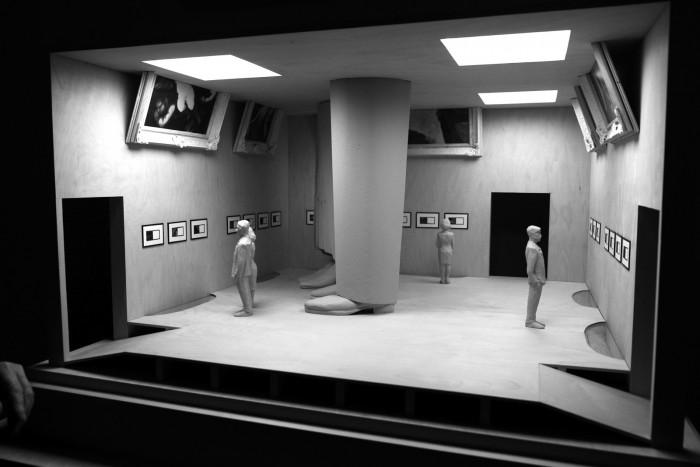
When you watch what’s happening, when you’re drawing, when you make your works, what unites all those things? For example, when a person is in love, he may start speaking in poems. So the very form of what he’s accepted defines the contents of what he’s going to say. In a way, your voice is tuned to what will happen later in art.
I would distinguish two phases. The first phase is a very pleasant feeling that I’m making non-art. I’ve always hated everything artistic. This is clearly a result of being educated in art school. I hated all those Rembrandts. I mean they affected me in a powerful way, but they were all far and above me; I was a pigmy—dusty, Soviet, human garbage—a creature thrown away, tossed to the corner, that could not have anything in common with those masters. So when I started making drawings I was that pile of garbage.
And yet, didn’t you say that when you lived in the boarding school the senior students broke those beautiful waffle…
Yes, yes, yes. But that was aggression. I was not aggressive, I considered myself a Mowgli living in a strange culture; I was an alien in that world. Culture belongs to this world. I couldn’t stand it. Or maybe not stand—that’s also aggressive… I felt it wasn’t for me. But there was an interesting development. The very fact that I was constantly drawing dragged me inside culture. It’s like a talentless rabbit who hasn’t been trained in the circus is sitting in the arena and starts thumping and drumming. I was very influenced by the spirit of the place. So the law of constant involvement is very important here.
So you’re that drumming rabbit, aren’t you?
Yes. I was drawing some stupid stuff, sticks, Soviet rubbish, but gradually—without realizing it—I began to draw within a cultural realm. And this cultural realm was expanding, becoming more and more museum-like. Drawing stopped being a personal pastime and became an ambition: What if this is displayed in a museum? Soon I started to see my works hanging on museum walls. What if people walking through this hall wouldn’t be horrified by…I mean, the work will take hold on the museum wall. This transition to museum art is very important. The museum is like the Wimbledon championship. You can play tennis in the backyard or you can play it at Wimbledon. The same applies to art. Maybe you’d say, ‘I have to retain my own style. I don’t give a shit about museums!’ But in my childhood, the museum was something incredible, something inaccessibly high. I spent my childhood in the museums.
Sleeping.
Yes, sleeping. I wanted to be in a museum. Not in the Russian State Museum, but in international museums. I wanted to be in the National Gallery in…
Uffizi?
No, not Uffizi—in the carriage called contemporary art, which is still hitched to the main train. If you live in modern times, you want to be in a modern art museum among the acknowledged artists.
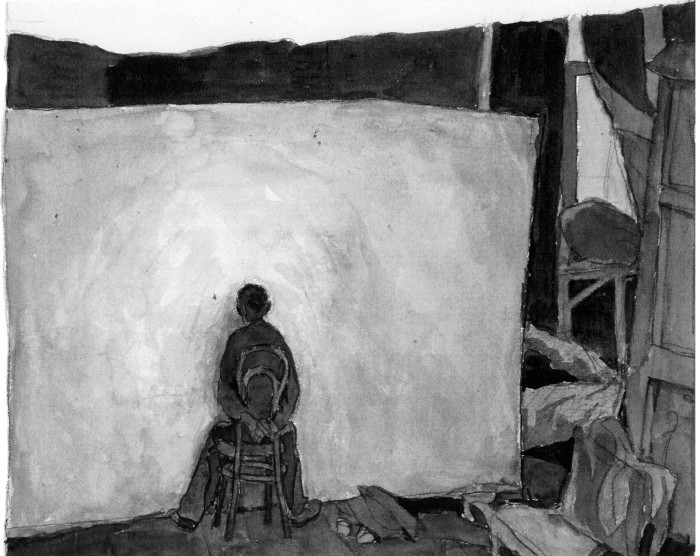
You once mentioned that you believe in a second birth, that initially you’re just this piece of meat from nowhere, but then, through a series of actions (no one knows what actions), you’re really born. I wonder when this happened to you—if it did—and what relation you have with the initial you.
I’d say it happens to some people when they meet a particular person. I think this is a normal and, probably, happy way. There are stories that go like that: I met this teacher, I met this friend, I met someone in the street: someone gave me a nudge, encouraged, instructed me; I managed to see a person in him and so became a person myself. It’s a general rule: you meet someone in this world. That’s how a biography usually begins: I was nobody, but then I met someone and became somebody. It’s a tradition of discipleship, meetings, sudden realization.
That’s my story for sure.
I’d call it the ‘path of encounter’. It’s a chain of encounters or maybe one important encounter that sets someone off. I’ve never had that kind of encounter. I had my helping angels, but they helped my career rather than my art. I’ve never had that sort of encounter with a person I respected. What I had was an encounter with general ideas, so to speak. Some things affect me as if they’re spirits of presence. For example, I would go to a conservatory, not to listen to particular music but to meet the spirit of music in that space. In a museum, I didn’t care about a particular artist; I met the spirit of the museum. I’ve found some spaces in this world that affect me deeply. So I’d say something rather than someone has influenced me.
It’s odd that you rely on something indefinite and unconscious.
That’s right. But I can see it better. In a person, I also see a cloud, not a personality. I’m interested in people who have that ‘room for things’. When I heard Piatigorsky speak, I could see something real behind him. He was talking about some house, and something emerged behind that story.
I feel no interest when a person says, ‘Pour me a cup of tea, please,’ or ‘Where were you yesterday?’—‘I went to see a film.’ Not interested. When a man opens his mouth, I instantly feel whether or not there’s a world behind him, whether there’s something behind each of his words. By ‘something’ I don’t mean something square, round or diagonal. It’s a large context. The world of context. The viewer should act in the same way.
I’ve come up with a question about this something. Let me remind you of a scene from one of Proust’s novels, I’m sure you know it: the writer, Bergotte, goes to a Vermeer exhibition, and there, on the picture, A View of Delft, he sees a yellow stain.
Yes, I remember it well.
He realizes that this stain is real life and dies instantly. So my question is: The ‘something’ behind this stain, what this stain represents, it’s not accidental… In a way, it’s eternal life. And Proust was afraid because he longed for immortality.
Yes, his books were an imitation of this immortality.
When you look at this ‘something’ that reveals itself in your pictures as well, don’t you want to understand what it is?
No. The presence of this ‘something’ is enough. There’s no need to understand it; it should just be present. There are many dark spots in Rembrandt’s pictures, but I don’t want to investigate them. I know there’s something in that darkness. Something you shouldn’t touch, I’d say. You shouldn’t touch it with any kind of perception, reason, hands, technique or formal method. The harder you try, the further it goes away.
That’s what Merab Mamardashvili says in his lectures on Proust: man can give away everything except for the darkness in himself that he doesn’t know.
Beautiful, I couldn’t have said it better. Beautiful. It’s this darkness that matters. As I’ve discovered in my life, the more you try to investigate it, the further away it gets. It’s like those spots in your eyes. When you want to look at them, they move to the side. This is a model of our consciousness. The more we want to see something, the more it plays with you and escapes you. Any intellectual or mechanical apparatus of yours cannot reach that darkness. It should just be there. Like a light spot. We feel the presence of something. Maybe scientists approach it differently. But they may know about this darkness. An artist develops a system of images because he knows he can’t touch it. And yet you have to grasp it in your…
In fact, scientists do deal with that subject. Arnis had a conversation with the great physicist, Leonard Susskind, one of the authors of string theory. He’s said that we can’t transfer the laws of our world to other worlds, so we have to accept our inability to understand other worlds. He says our having two hands with five fingers on each—that’s a contingency. It isn’t based on anything. In other worlds, those five fingers may not exist.
That’s absolutely right.
That world is completely different. And man can’t accept that somewhere there’s something…
That doesn’t have five fingers.
Exactly.
It’s this deification of man which started during the Renaissance: man is the most important creature on earth; he can understand everything, make everything, change everything. The Middle Ages’ attitude towards man was much more moderate. But we’re the children of the Renaissance. We can do everything. But the more we touch, the worse our condition becomes. We can’t help touching, because we are men. It’s in our nature to touch and to make. It’s important to remember (in art and music) that we can do something, but when we touch things, we create this huge realm of the unknown. When we touch things, we touch lots of them! Let’s say I raise this cup. This cup is raised. But there are many things connected to this cup that I’m not aware of. And they follow this cup. There was emptiness, and we stirred it without even knowing what emptiness is. The same applies to art. We’ve depicted something, and this means we’ve touched something we didn’t mean to depict. We have stirred the non-depicted.
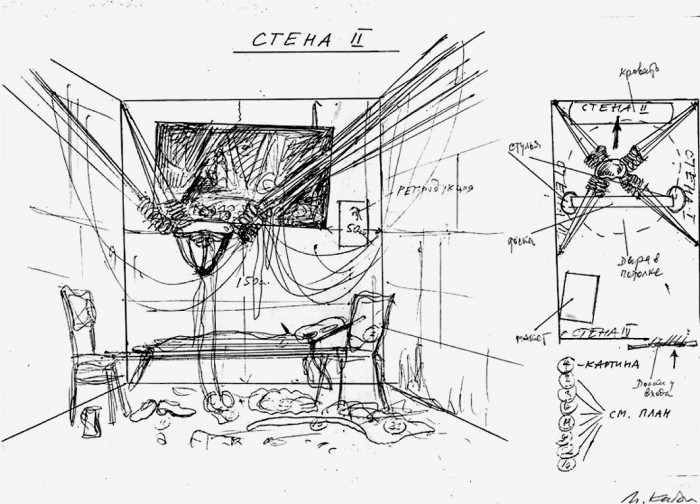
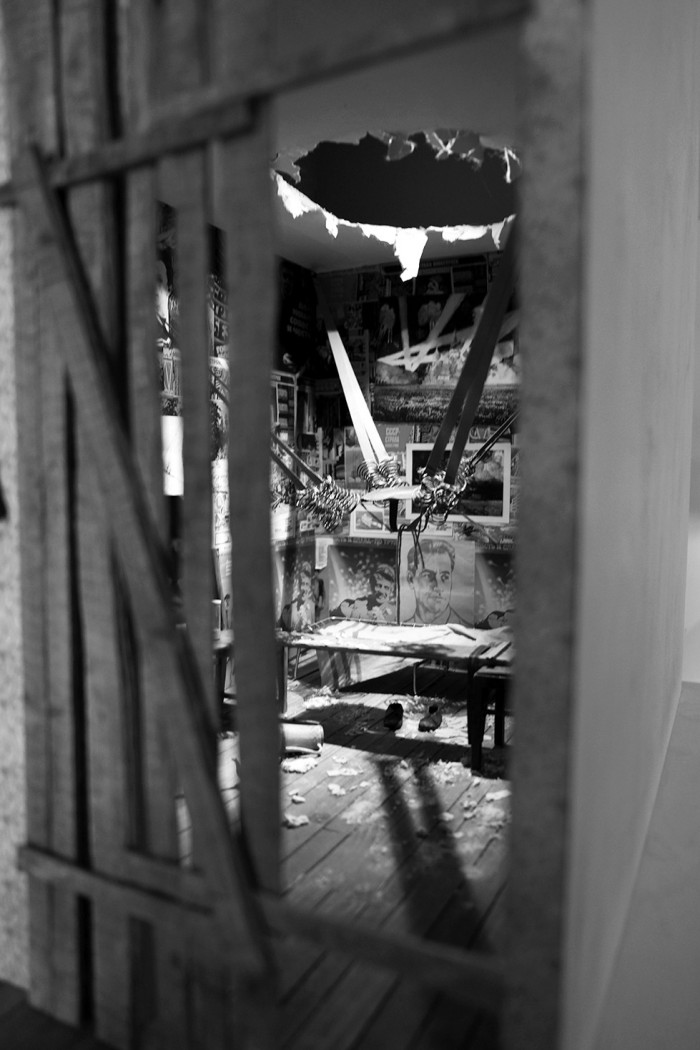
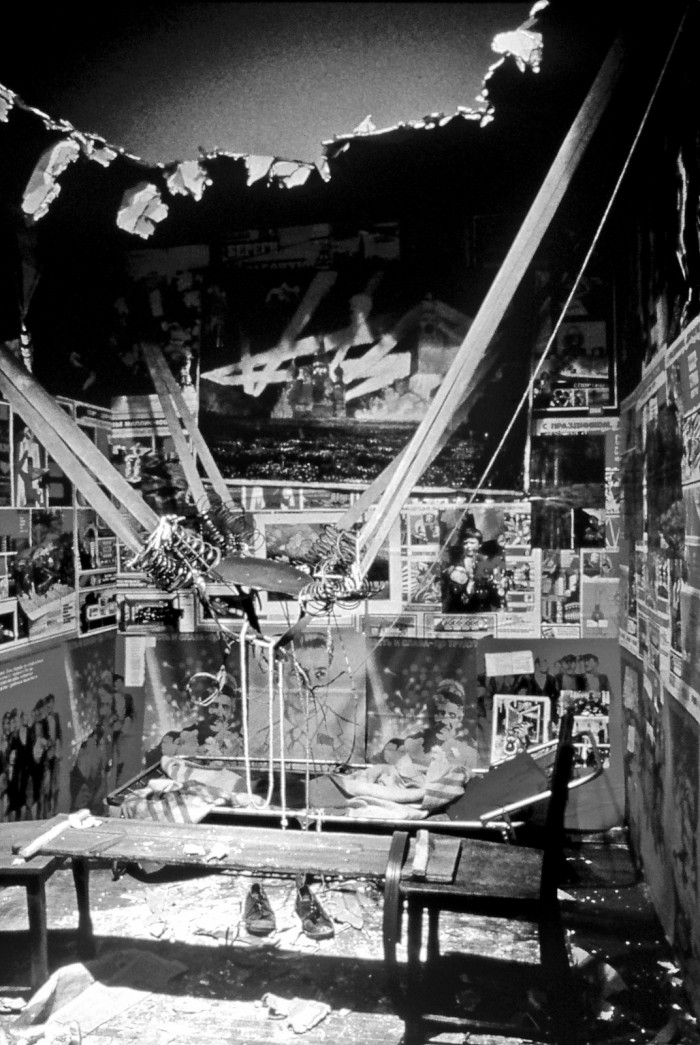
When I asked about the objects that become parts of your works, I was trying to find out how significant these objects are for you. Or perhaps you’re only concerned with emptiness as you look at what hasn’t been depicted behind these objects.
The emptiness always appears as the last level, or the last layer. Everything depicted has its end in the emptiness. As long as it’s depicted, it has to be associated with something known. We can’t know the depth of life, but we can use the things we know. One does not exclude the other. Emptiness doesn’t mean that I have to fall asleep and perish. I have to use all my fingers, if you will. My fingers are not just me; they’re part of a genetic chain that stretches from past to future.
When I read the conversations with literary scholars, not scientists, in your magazine, I was astonished by the degree of despair, anguish and hopelessness they expressed in every sentence. Almost everyone was talking about despair and senselessness. I think it’s a consequence of this Renaissance psychology that deprives man of everything but himself. His life is nothing but perseverance… He knows nothing but himself. I think it’s unfortunate. In fact, we’re but a small part of ourselves. I belong to the Russian tradition where ‘I’ exists only as a part of ‘everything’. There is, of course, such a thing as ‘I’, but it’s fraught with ‘everything’. And this ‘everything’ is much more interesting than ‘I’.
When you mentioned the fingers, I recalled your funny story, how you worried about your toe that was unnaturally longer than the others. Amazingly, its irregularity is a sign of something that is ‘everything’.
Since childhood, I think I’ve have had an unusually developed sense of the norm, the norm as something mandatory and important. So this ugly toe frightened me. Another person may see it as my peculiarity. But I don’t like peculiarities. I stick to genetic norms. Probably, this has something to do with me being Jewish—or with Russian literature, with its disdain for the peculiar, for being a person, and its focus on the normative and this fear of deviating from the norm. Deviating from the norm is the main horror of Russian life. There used to be a golden norm but we lost it—during the tsars or Soviet power. Restoration of a moral, religious or any other norm, the right way, is the main subject of Russian thinking, whereas Western thinking aims to distinguish the individual, to single out this ‘I’ from the norm, or even reject the norm completely.
So you’re a normal Russian.
A normal Russian, yes. I’m very ill, Soviet, but when it comes to opinions and ideals, I’m a normal Russian. It sounds funny though…
I’ve just had an idea. Is Nevsky Prospect that way?
Yes, over there.
In Norstein’s unfinished film, Overcoat, there’s a brilliant scene that takes place on Nevsky Prospect. Akaky Akakievich’s co-workers are running down a brightly lit Nevsky Prospect; someone takes off his hat and throws it into the darkness—where the street ends. They run back to the light, and for a moment, he remains standing in front of the darkness. He’s sad about losing the hat, but then he turns around and runs after the others.
To walk down the brightly lit Nevsky. That’s right, I agree. The thing is (and this probably relates to the Russian tradition), there’s darkness everywhere, and only one road lit by lanterns.
The one that leads to the prison camp, for example.
Of course. Ideally, this is the right way.
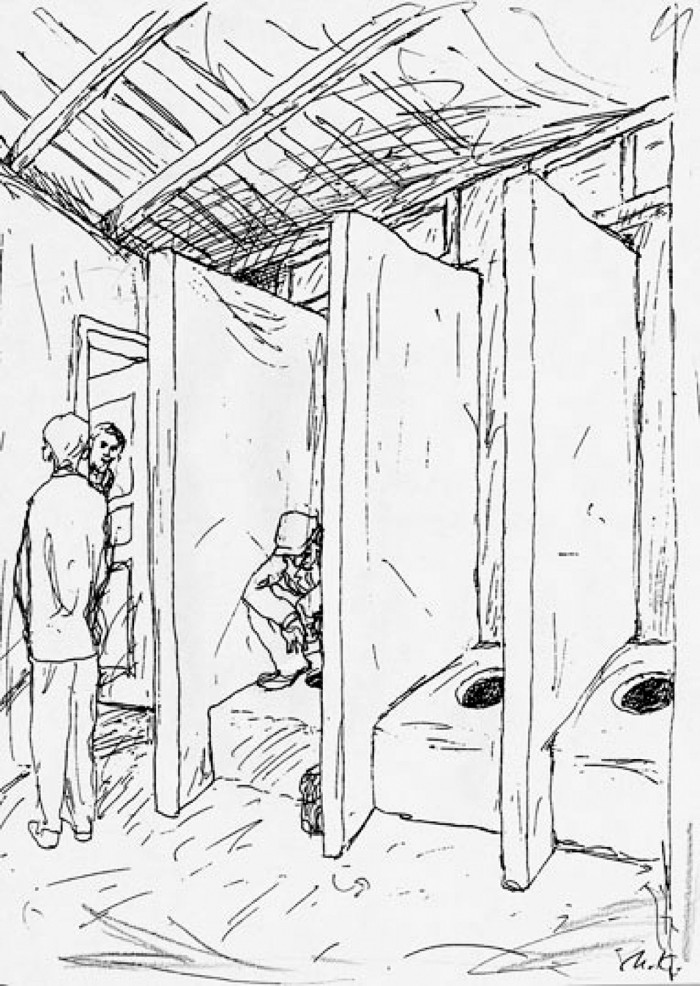

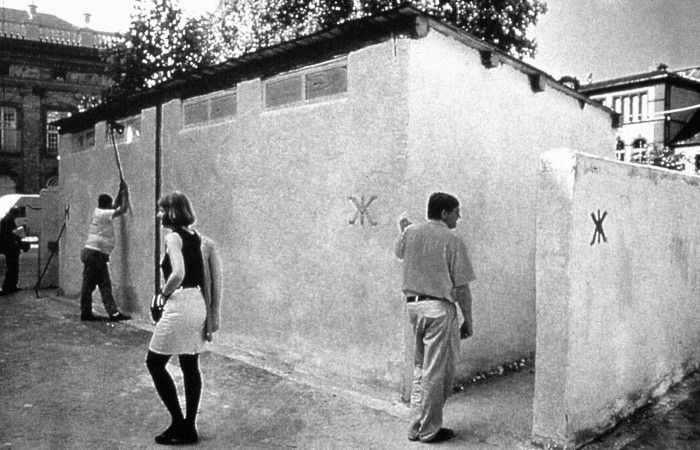
Ilya, if you don’t perceive yourself in any way and only pay attention to where you are, then what’s your attitude to all of this?
No attitude. None. We don’t have a criterion for that. The more I live, the less I’m interested and the less I understand.
So you don’t want to be like others, have fun, watch television.
No, we have a TV. Emilia and I have everything, you know. You can live on a minimal set of things. We have a bit too much. The minimum includes food, some clothes and a warm room. I’m talking about the life of an artist. This is all he needs. Aside from this, no one should disturb him and his works must be safe. That’s it.
I thought about this because Piatigorsky writes in a preface to one of his novels that if someone tries to come back from the philosophical condition he’s reached, the place to which he returns will be much lower than the one where he was when he started to study philosophy. So there’s nowhere to come back to.
Nowhere. And no wish to. The survival instinct of an artist makes him do whatever it takes to make a picture the next day. All the rest is his enemy. I can see these enemies from afar and I don’t fight. I try to escape the situation so I can work the next morning.
Great. I should be going now.
My pleasure.
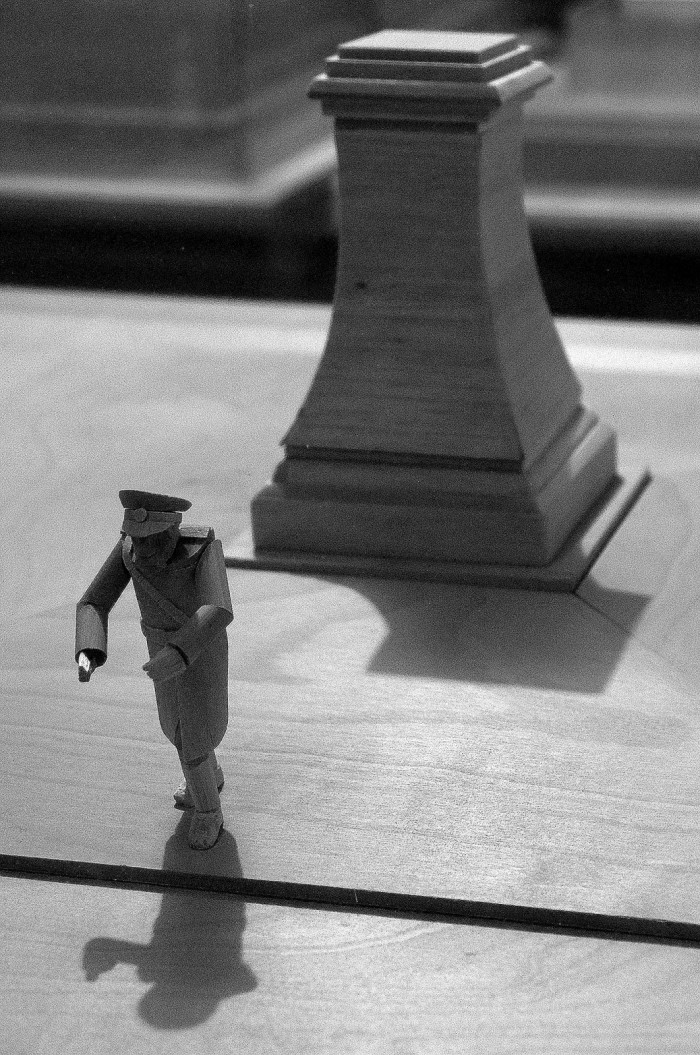
Questions by Arnis Rītups and Uldis Tīrons
Translated by Petr Serebrenniy